Research Article
Prevalence of Substance Abuse among the School Students in Al-Dhahirah Governorate, Sultanate of Oman
School of Pharmacy, College of Pharmacy and Nursing, University of Nizwa, Oman
*Corresponding author: Jamaluddin Shaikh, Associate Professor, College of Pharmacy and Nursing, University of Nizwa, Oman, E-mail: jamaluddin@unizwa.edu.om
Received: June 13, 2018 Accepted: June 28, 2018 Published: July 3, 2018
Citation: Hamed Al-Alawi AS, Shaikh J. Prevalence of Substance Abuse among the School Students in Al-Dhahirah Governorate, Sultanate of Oman. Madridge J Nurs. 2018; 3(1): 118-123. doi: 10.18689/mjn-1000121
Copyright: © 2018 The Author(s). This work is licensed under a Creative Commons Attribution 4.0 International License, which permits unrestricted use, distribution, and reproduction in any medium, provided the original work is properly cited.
Abstract
Background: Substance abuse is one of the public health hazards in Sultanate of Oman. The prevalence of substance abuse among young population is alarming. The problem is not only harmful for individuals but also provides negative impact on families and society. However, little is known about the prevalence of substance use among adolescents in Sultanate of Oman. The aim of this study is to assess the prevalence of substance abuse among school students in Al-Dhahirah Governorate in Sultanate of Oman.
Methodology: This study was carried out in Al-Dhahirah Governorate, Sultanate of Oman during 2015-2016 among school students. To fulfill the objectives, a self-administered questionnaire was randomly distributed to the schools. Students from grade 9 to grade 12 (both male and female) were participated. A questionnaire (20 items) was developed for the purpose of this study. It was having a component to obtain information on demographics of the participants as well. Collected data were evaluated to assess the response of the participants. The obtained response was correlated with the demographics of the participants.
Results: A total of 614 participants were included in this study. Data obtained from this study showed that one-fifth (20.7%) of the respondents were abusing substance. The majority of abusers in this study were taken stimulants (25%), followed by sedatives (18%). The study also showed that a considerable per cent of people used tobacco (17%), poly substance (16%), paint (13%), glue (6%) and alcohol (5%). Most of the substance abusers were started abusing substances before grade 9 (48%) followed by grade 9 (32%). Abusers were mainly taken substances alone (55%), and with friends (28%). About 40% of the abusers in the present survey addressed the study problem is the main cause for substances addiction. The survey also confirmed that about two-fifth (38%) of abusers knew the way of distribution of the substances.
Conclusion: This study was gone well in collecting the information and making it in a clear picture regarding substance abuses in school students. Data found in this study showed that the stimulants were the most common abused substance in Al-Dhahirah Governorate due to many causes, the most common one is study problems among the abusers and the level of abusing may continue to next grade-stage in their life as we observed fifty six percent of them were not able to stop abusing substances.
Keywords: Substance abuse; Alcohol; Tobacco; Sedative; Stimulant; Oman.
Introduction
Substance abuse is a growing problem in the world. Millions of people throughout the world are abusing substances such as alcohol, nicotine, cocaine, methamphetamine, morphine, marijuana, heroin and many others. One of the available global reports indicates that between 3.4 and 6.6 percent of the adult population are using illicit drugs [1].
By definition, a substance abuse refers to injurious or harmful use of psychoactive substances that include alcohol and illegal drugs. The psychoactive substances abusers have always a strong desire to repeat the dose. They find difficulty to control the use of these substances or may suffer from withdrawal effects [2]. There are many potential risk factors that escalate the risk of substances abuse. These include genetic factors, family environment, lack of parental attachment, outside environment and mental health [3].
Most of the time people abuse substances to improve their performances or to reduce problems like stress, depression and anxiety. Habit of substance abuse leads to various problems in people's daily life's activities towards family, school and work for example. It may leads to complications in their relationships such as; they may not fit with friends and family members. Ignoring children, dropout in school or loss of job are also associated with substance abuse. Frequently, substance abusers may get into legal trouble like driving under the influence of the toxic effect of the substance [4].
Substance abuse is not only affecting the adult people, it also seriously influencing the school going children. Adolescence is the developmental phase at serious risk for the onset of substance use related issue, and at this stage students are most likely to abuse substances for the first time in their life [5]. The stage for onset of behaviors and conditions is flourished at adolescent, and this phase of life is not only affecting health limited to that time but also lead to adulthood behaviors [6]. In other words, early use of many substances such as alcohol, tobacco and illicit drugs use are the predisposing factors for misusing those substances in later life. For example, individuals who first use alcohol in adolescent years are vulnerable to subsequently extending alcohol abuse or alcohol dependence in their later life [7]. Tobacco use is the most significant preventable cause of premature death worldwide and most adult smokers start smoking in adolescence [8]. Not only that, adolescents who start smoking at younger age are also more prone to become habitual smokers and less likely to quit [9]. Moreover, daily use of tobacco among adolescents is closely associated with cannabis starting and other substances [10].
Drug use and abuse is becoming a public health problem in Middle Eastern countries. Despite the social, cultural and religious unacceptability in Middle Eastern countries, illicit drug use is an alarming situation in this region [11]. As like global trend, substance abuse among adolescents in this region is a serious problem as well. It leads to serious effects at the health, economic, social and legal aspects that interfere with the development of the countries. The most exposed groups are the children living in poor conditions, jobless youth and secondary school students who are at high risk of using drugs [12]. A recent study showed that more than one third of secondary school students in Saudi Arabia smoke cigarettes, 9.3% drink alcohol, and 8.8% abuse other illicit drugs including glue/solvents and stimulants [13]. Other studies also confirmed the most used drugs in the Arabian region are tobacco, psychotropic drugs, alcohol and cannabis [13,14].
Oman is an Arabic and Islamic country, located at the south-east border of Arabian Peninsula. There are nine governorates of Oman. Al-Dhahirah Governorate is one of the heavily populated governorates with a total population of nearly 200,000, out of a total of 2.5 million Omani. It is located in the north-west of Oman, close to the border with UAE (United Arab Emirates). Just because of its location the influence of substance abuse which is prevalent in UAE is likely to be more prevalent in Al-Dhahirah Governorate.
In the Sultanate of Oman little is known about the prevalence of substance use among youth [15] and hence the importance of the complication is not known. The need of the present study is to get an estimate about the substance abuse among school going children in Al-Dhahirah Governorate in Sultanate of Oman. This study may help the existing institutions, governments and the Ministries of Health and Education to take advantages of these observations to establish a healthy society.
Material and Methods
This is a prospective survey with the use of questionnaires to estimate the prevalence of substance abuse among the secondary school students in Al-Dhahirah Governorate, Sultanate of Oman. The study was conducted during 2015-2016 by using self-administered questionnaires that included demographic parameters and questions about substance abuse. Students' demographic parameters were also used in this study. The parents' cultural parameters include employment and education. Directly related questions concerning the onset of substance use, the type of substances, fellow substance users, reasons for abuse, disadvantages of substance use like absent from school and medical problems associated with abuse, knowledge about the distribution of the substances, role of school surrounding in substance abuse were all included in the questionnaire. 614 Omani students from grade ninth to twelfth were participated in the survey. The questionnaires were based on the following standardized international questionnaires used in previous similar studies [16]. These questionnaires are translated to Arabic (the local language) and validated. The validity was established by checking in a small population of subjects. All the obtained data were analyzed and illustrated in histograms using Microsoft Excel programs.
Results
The present study was carried out in the Al-Dhahirah Governorates in Sultanate of Oman for both sexes and different grades among Omani students. The total numbers of respondents were 614. Among the participated students, the percentage of male and female students was almost equal (49% male vs. 51% female), and students were evenly distributed among different grades (ninth to twelfth grade). Regarding parents' educational qualification, most of them were high school graduates (48%) followed by higher education degree holders (28%).
In the present study, students were asked if they had ever used drugs other than those required for medical purpose. The results (Figure 1) demonstrated that nearly one-fifth (20.7%) of the participants reported that they had abused one or more substances at least once in their life time. Among the male and female participants, 24% male abused substance compared to 17% female abusers.
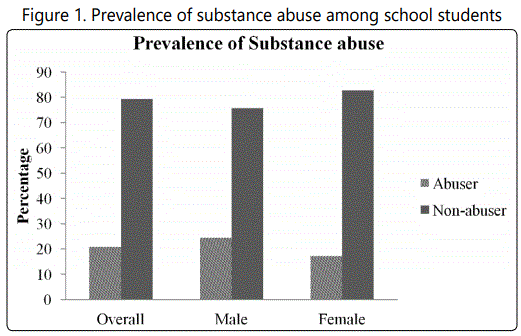
The frequency of substance use among the abusers was assessed for ninth to twelfth grades, and most of the abusers (48%) indicated their starting point of substance abuse before grade 9. A considerable group of abusers (32%) confirmed their starting point at grade 9 (Figure 2). A small portion of students were found from grade 10 (14%), grade 11 (4%) and grade 12 (2%). A similar trend was observed for both male (before grade 9: 51% and grade 9: 28%) and female (before grade 9: 45% and grade 9: 38%) abusers (Figure 2).
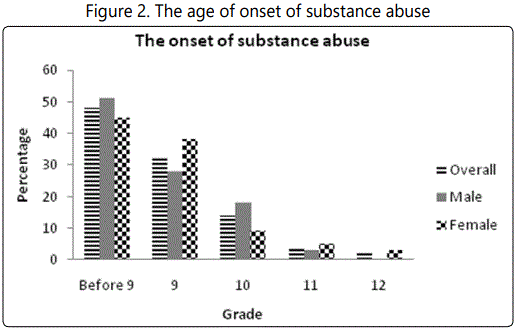
Concerning the commonly used substances the majority of the abusers affirmed the use of stimulant (25%), sedative (18%) and tobacco (17%) as appeared in figure 3. The results also showed that abusers were involved with other illicit drugs (paint 13%, glue 6% and alcohol 5%). Considerable portions (16%) of abusers were involved with more than one substance at the same time.
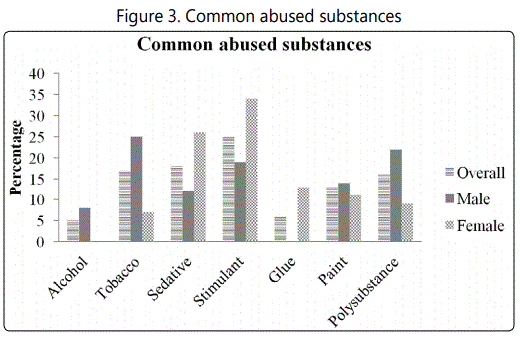
Figure 4 showed that more than half of the abusers (55%) used substances when they stayed alone. About one-fourth of them (28%) indicated that they were accompanied by their friends for abuse substances. When subdivided into male and female categories, there were not many differences in observations. Only difference was that the males (37%) were more interested to make association with friends than female (15%) abusers.
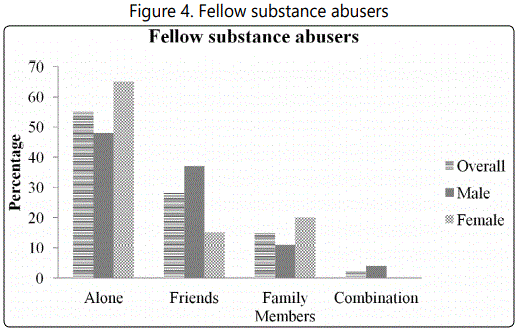
Regarding the opinion of the abusers about reasons behind the use of substances, it was found that 40% of the abusers disclosed that study problems were the main reasons for substances abuse. Other important indications for the reasons behind the substance abuse were bad relation (27%), followed by family problems (17%). After segregating the results among males and females, study problems were the main reasons for males (53%); whereas, bad relations were for females (48%) as indicated in figure 5.
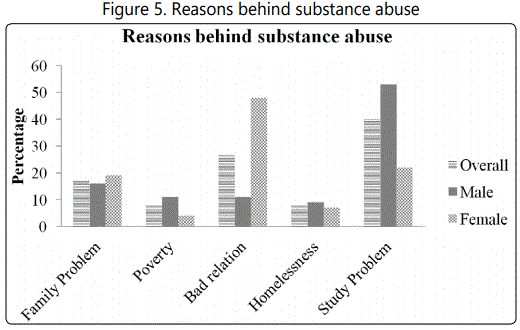
In the present study, abusers were asked if the substance abuse forced them to absent from school. The results indicated that one-third (33%) of them reported the affirmative response. Results from this study also outlined that 38% abusers knew some way of distribution of the substances. Abusers also confirmed that the surrounding of the school was responsible for facilitating the substance abuse.
Discussion
People's life can be influenced by lifestyle, level of education, health, social relations, economic status and religious belief. The substantial changes that an individual experiences in adolescence age are considered as most crucial and difficult period in individuals' life. At this particular age, individuals like to get independence, so they do such thing that may even dangerous not only for themselves but for society as well.
Substance abuse is the most common social calamity practiced during adolescence. The major aim of this study was to evaluate the prevalence and patterns of substance use among secondary school students in Al-Dhahirah Governorate in Sultanate of Oman and assess some of the situational contexts of substance abuse. Although abusing substances are unacceptable in relation to social, cultural and religious aspects in Arabian countries, the recent trend is indicating that it is a great concern for this region, as like it is a global concern [11].
The tendency for substance abuse in secondary school survey suggested that about one-fifth of the students in our study were abused substances. The higher number of male students in our study, as shown in the gender distribution, is comparable to observations from previous studies [17,18].
In our study, the most of the abusers were from grade 9 and before grade 9. This observation is similar to that of a Saudi Arabian study which reported that the age of smoking was started among adolescents ranged between 10 and 15 years [19]. Previous study from Nigeria showed that average starting age for substance abuse is 15.9 years that is the high risk age group for substances abuse [20,21]. Age of initiating of substance abuse in a South African study also confirmed the current findings [22].
Majority of the students in our study were abusing stimulant, which is supported by a Nigerian study [23]. However, non-medical use of stimulant among Canadian and US students are comparatively less than our findings [24,25]. The difference may be due to the easy availability of khat (Catha edulis), which is a common herbal stimulant use in Arabian is countries. One of the Saudi Arabian study revealed that prevalence of khat use is 21.5% among secondary school students [26]. Probably, widespread use of khat in the Arabian countries reflected our study, as it is one of the major contributing factors in the category of stimulant.
Sedatives are one of the commonly abused substances. Current findings are in accordance with that of Al-Sayed (2014) who reported that prevalence of sedative among young people, especially in Arabian counties such as Saudi Arabia is wide spread [27]. A higher rate of Sedative abuse among students also reported in China [28].
Out of varieties of substances, a considerable percentage of students use tobacco. Our studies showed quite less prevalence of tobacco use (17%) than a study in Abha City in Saudi Arabia [13]. Several other studies also consistently reported the high rate of smoking among male students in Saudi Arabia [14]. However, prevalence of tobacco use in our study is similar to findings from previous studies among secondary students in Lagos, Nigeria [29]. A comparable finding from US among school students in 2014 also supports our observations [30].
Although acceptability of alcohol is rare in Arabian countries because of religious belief, it is not totally abundant in this area. In this study, about 5% of the students among abusers appeared to consume alcohol. Our finding is in accordance to the Saudi Arabian finding [13]. However, present findings indicated a much less prevalence of alcohol abuse among school students than that of United States [31]. Religious belief and limited accessibility of alcohol in this region is the probable factor for its less prevalence. Historically, consumption of alcohol by females is less prevalence than by males [32] which reflected in our findings.
The last substances which reported in the present study were volatile solvents, like glue and paint. It is quite obvious from the previous [33] finding that volatile substance is a common substance abused by the students [34].
From the tendency of abusing substances among students, it is noticed that majority of the students preferred to abuse substances alone followed by friends and family members. An Iranian study (2015) indicated that the prevalence of substance abuse was higher among the students who lived alone [35]. There are numerous social risk factors for substance abuse, one of them is the exposure to friend who abuse substances. Several studies have reported that adolescents are likely to be a smoker if they have friends who smoke [36]. This may be due to the adolescent age when they are likely to adopt to peer social influences to fulfill their requirement for social association. These observations are in line with our study where students prefer to abuse sedative and stimulant alone; whereas, drinking alcohol and smoking tobacco with friends. In addition, it is socially acceptable norm in this region to chew khat with the friends and family members. Previously published report indicated that khat chewing alone is much less than using khat with friends and family members. The tendency to use khat for female students is more with family and relatives, while male students use khat mostly with friends [37]. Because of social structure of this region, female students are mostly used the substances like sedative and stimulants alone, and khat with family members; whereas, male students are used substances both alone and with their friends.
Majority of the abusers in the present study indicated that study problems are the main cause for substances addiction. In addition, bad relations and family problems are other reasons for abusing substances. This observation is supported by the finding of different studies. Aklog et al (2013) reported that study related adjustment, peer pressure, psychological and environmental factors are the common cause of substance abuse [38]. Many students believe that stimulation of their brain with substances helps them to study properly and overcome academic pressure and meet deadline. Another study about determinants of substance abuse in high school students indicated some of the contributing factors that lead to substance abuse were parents' divorce, family problem, psychological disorders, and strictness of parents [39]. Family influences on adolescent substance abuse are important, but complex. In this aspect, relationships among family members and parental role modeling are important as well [40]. Some of the family factors which lead to substance abuse comprise inadequate family management by parents, for example, indiscipline and pessimistic communication techniques [41]. An environmental influence such as socio-economic status, which comprises both social and economic factors, also attributes substance abuse. It is also reported that living in a poor neighborhood and low income level are important risk component for trouble some behaviors, including substance abuse [40].
Conclusion
This study was carried out among the school students in the Al-Dhahirah Governorate, Sultanate of Oman. The questionnaire distributed between male and female from grade 9 to grade 12. The most abuse substance was stimulants. The collected information was helpful in describing and translating an idea about the schools. In respect of respondent abusers, males were more than females and majority of abusers were from grade 9. Regarding the addictive substances, majority of males were abusing tobacco; whereas, females were abusing stimulants. Study problem and bad relation were among the causes that encourage them to use these substances. The study also showed that most of the students did not feel any guilty about their habit of abusing substance and about two-fifth of them know some way of distributing substances.
Recommendations
Nurses are basically part of a school student's wellbeing team, working together to address students health promotion. They may cover both health and educational goals. Students nowadays face family crises, homelessness, poverty, and violence, which escalate their tendency to abuse substances. By regular school nurse activities like screenings and interaction with school staff, the school nurse can identify possible dangers that place the student at a higher risk for future substance abuse or can recognize probable preventive factors, which lower the risk of students to develop a substance abuse complication. In brief, through careful evaluation and identification of substance abuse risk factors, the school nurse can play an essential role in the prevention of substance abuse. The school nurse may also be able to identify possible protective measures such as supporting the family, commitment in school activities, and a secure physical and psychological setting both inside and outside of school. Dissemination of current findings may assist school nurse to manage the wellbeing of the school students in general, and substance abuse habit in particular with the coordination of institutions, government agencies, and sponsors to eliminate this social calamity.
Acknowledgment
We would like to express our thanks and gratitude to the University of Nizwa and the College of Pharmacy and Nursing for giving this opportunity to conduct this research via the provision of the academic programs. Our thanks are also extended to the respected managers of respective schools without their kind cooperation this study cannot be conducted.
Declaration of Conflicts of Interest
The authors declared no conflicts of interest with respect to the authorship and/or publication of this.
References